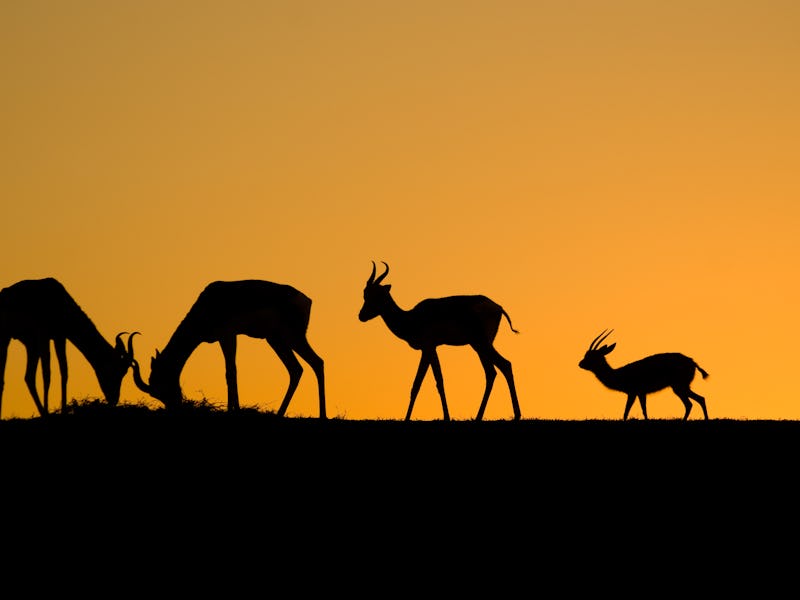Early Global Warming Was Unexpectedly Caused by a Burst of Tiny Life Forms
The Earth's temperature rose by about 5°C.

Climate change today is synonymous with the loss of life. Here’s a sampling of the things it is killing: corals, the Arabian sea, all the polar bears, and Miami. It is also, paradoxically, also synonymous with too much life — just as it’s always been, as a new Nature Communications article shows. In the paper, researchers draw a parallel between present-day human activity and a sharp uptick in life over 500 million years ago that led to the Cambrian period’s huge global warming event.
Before the animals we know emerged on land and in the sea, there were tiny, burrowing organisms on the ocean floor. And before they existed, there were thick mats of microbes at the bottom of the sea. In the paper, the team of researchers from Belgium and the UK show that, when the tiny burrowers evolved and dug into those organic mats about 500 million years ago, they triggered a massive global warming event. As study co-author and University of Leeds geoscientist Benjamin Mills, Ph.D. explained to Inverse in an email, the resulting release of massive amounts of carbon dioxide (CO2) into the Earth’s atmosphere led to a sharp increase in global temperature over the next several million years.
“In our model, atmospheric CO2 increases by around 1000 ppm, causing something like 5 degrees increase in average surface temperature,” Mills says. “Warming occurs over several million years, but climate remains hot for a very long time afterwards because the process of organic matter oxidation is not shut off. The new hotter steady state that persists for maybe 80 million years.”
Here's a modern seafloor bioturbated by large marine worms.
The uptick in temperature all comes down to bioturbation — the process by which the tiny animals overturned sediments at the bottom of the sea, uncovering long-buried carbon that eventually made its way out of the ocean and into the air. Meanwhile, as these animals thrived in the sea, they breathed in ocean oxygen and breathed out even more carbon dioxide. Scientists have long known that there was an increase in global temperature around 520-540 million years ago, but no one really thought it was caused by these little bioturbators because their tiny movements seemed so insignificant. This assumption was incorrect, says Mills.
“The animals of the early Cambrian didn’t burrow very deeply into the sediment, maybe only ~1cm, therefore it has been generally assumed that their impact was minimal (both in terms of causing anoxia [low oxygen] and in terms of CO2 release from organic matter oxidation),” he says. Because the burrowers that came later dug deeper — this much was clear from the fossil record — scientists had assumed they had a bigger impact. But the team’s study showed: Don’t doubt the little guys.
Here's how extensive burrow networks in the sea floor can be. These were created by modern bioturbating worms.
“Our work builds on preliminary studies that suggest that shallow burrowing is in fact sufficient to have a major impact on sediment chemistry,” he says. In the study, Mills and his colleagues built a mathematical model that takes the evolution of these little animals into account. Using this model, they simulated what the Earth was like at this time, quantifying all the additional carbon dioxide in the atmosphere and calculating just how warm it got.
Trilobites, tiny benthic animals of the Cambrian period, would likely have played a role in churning up long-buried carbon and releasing it into the atmosphere.
The tiny bioturbators did not make life easy for any other organism that evolved over the next 80 or so million years. In fact, the team notes in the paper, it’s even possible the rise in global temperature and decrease in ocean oxygen that they induced led to multiple mass extinctions. “There is a strong correlation between ocean anoxia, positive δ13C carbon excursions and extinction events, and it is possible that the interactions between burrowing macrofauna, biogeochemical cycling and ocean anoxia may have contributed to these patterns,” they write.
If this feels a little too close for comfort, that’s because it is. Humans, like the little bioturbators, are now releasing huge amounts of carbon dioxide into the atmosphere, and the rising temperatures are leading to mass extinctions. The difference is that global warming is happening much faster this time around. While the Cambrian global warming event happened over millions of years, anthropogenic climate change has been occurring since the middle of the 20th century. We are in danger of causing a rise of 2 °C, and it’s only been about 70 years.
“The events of the Cambrian played out over millions of years, and appear to have been problematic for the biosphere at the time, whereas humans may be able to cause this level of warming and ocean deoxygenation over only hundreds (or thousands for anoxia) of years,” says Mills.
There are ways for humans to intervene, of course; the problem is getting people to actually do those things. Mills thinks the best way to mitigate the effects of decreased ocean oxygen is to stop dumping chemicals into the water that cause oxygen-sucking algae to bloom.
“Present anoxia is driven primarily by the runoff of nutrients (e.g. phosphorus from fertilizers) into the ocean and is best mitigated by reducing these fluxes through agricultural and catchment management changes,” he says.